The Cambridge History of China. Vol. 12: Republican China, 1912-1949, Part 1
Подождите немного. Документ загружается.

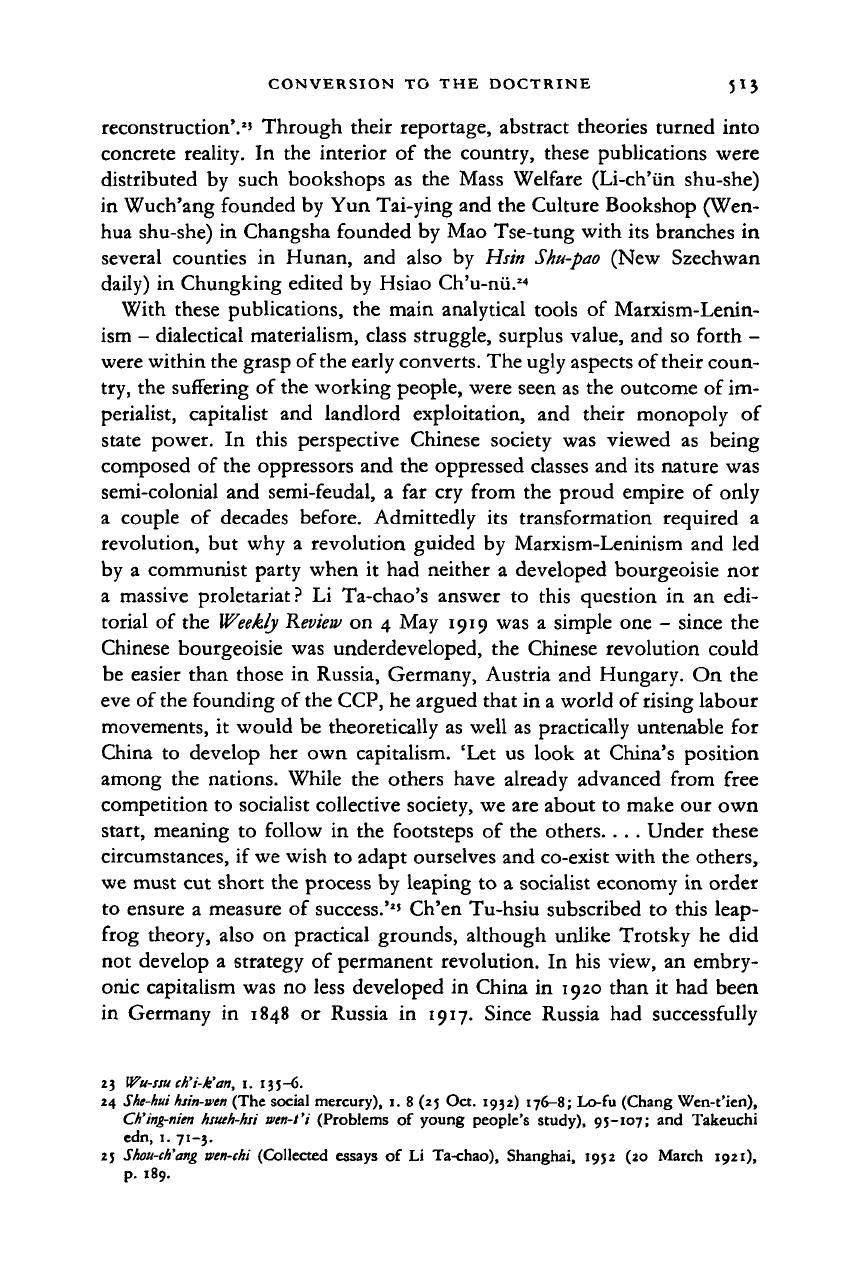
CONVERSION TO THE DOCTRINE 5I3
reconstruction'.
2
' Through their reportage, abstract theories turned into
concrete reality. In the interior of the country, these publications were
distributed by such bookshops as the Mass Welfare (Li-ch'iin shu-she)
in Wuch'ang founded by Yun Tai-ying and the Culture Bookshop (Wen-
hua shu-she) in Changsha founded by Mao Tse-tung with its branches in
several counties in Hunan, and also by Hsin
Shu-pao
(New Szechwan
daily) in Chungking edited by Hsiao Ch'u-nii.
24
With these publications, the main analytical tools of Marxism-Lenin-
ism - dialectical materialism, class struggle, surplus value, and so forth -
were within the grasp of the early converts. The ugly aspects of their coun-
try, the suffering of the working people, were seen as the outcome of im-
perialist, capitalist and landlord exploitation, and their monopoly of
state power. In this perspective Chinese society was viewed as being
composed of the oppressors and the oppressed classes and its nature was
semi-colonial and semi-feudal, a far cry from the proud empire of only
a couple of decades before. Admittedly its transformation required a
revolution, but why a revolution guided by Marxism-Leninism and led
by a communist party when it had neither a developed bourgeoisie nor
a massive proletariat? Li Ta-chao's answer to this question in an edi-
torial of the Weekly
Review
on 4 May 1919 was a simple one - since the
Chinese bourgeoisie was underdeveloped, the Chinese revolution could
be easier than those in Russia, Germany, Austria and Hungary. On the
eve of the founding of the CCP, he argued that in a world of rising labour
movements, it would be theoretically as well as practically untenable for
China to develop her own capitalism. 'Let us look at China's position
among the nations. While the others have already advanced from free
competition to socialist collective society, we are about to make our own
start, meaning to follow in the footsteps of the others. . . . Under these
circumstances, if we wish to adapt ourselves and co-exist with the others,
we must cut short the process by leaping to a socialist economy in order
to ensure a measure of success.'
2
' Ch'en Tu-hsiu subscribed to this leap-
frog theory, also on practical grounds, although unlike Trotsky he did
not develop a strategy of permanent revolution. In his view, an embry-
onic capitalism was no less developed in China in 1920 than it had been
in Germany in 1848 or Russia in 1917. Since Russia had successfully
23
Wu-ssu
ctii-k'an, i. 135-6.
24
She-hui hsin-wen
(The social mercury), 1. 8 (25 Oct. 1932) 176-8; Lo-fu (Chang Wen-t'ien),
Ch'ing-nien hsuth-hsi
wen-t'i (Problems of young people's study), 95-107; and Takeuchi
edn,
1. 71-3.
25
Shou-ch'ang
aen-chi (Collected essays of Li Ta-chao), Shanghai, 1952 (20 March 1921),
p.
189.
Cambridge Histories Online © Cambridge University Press, 2008
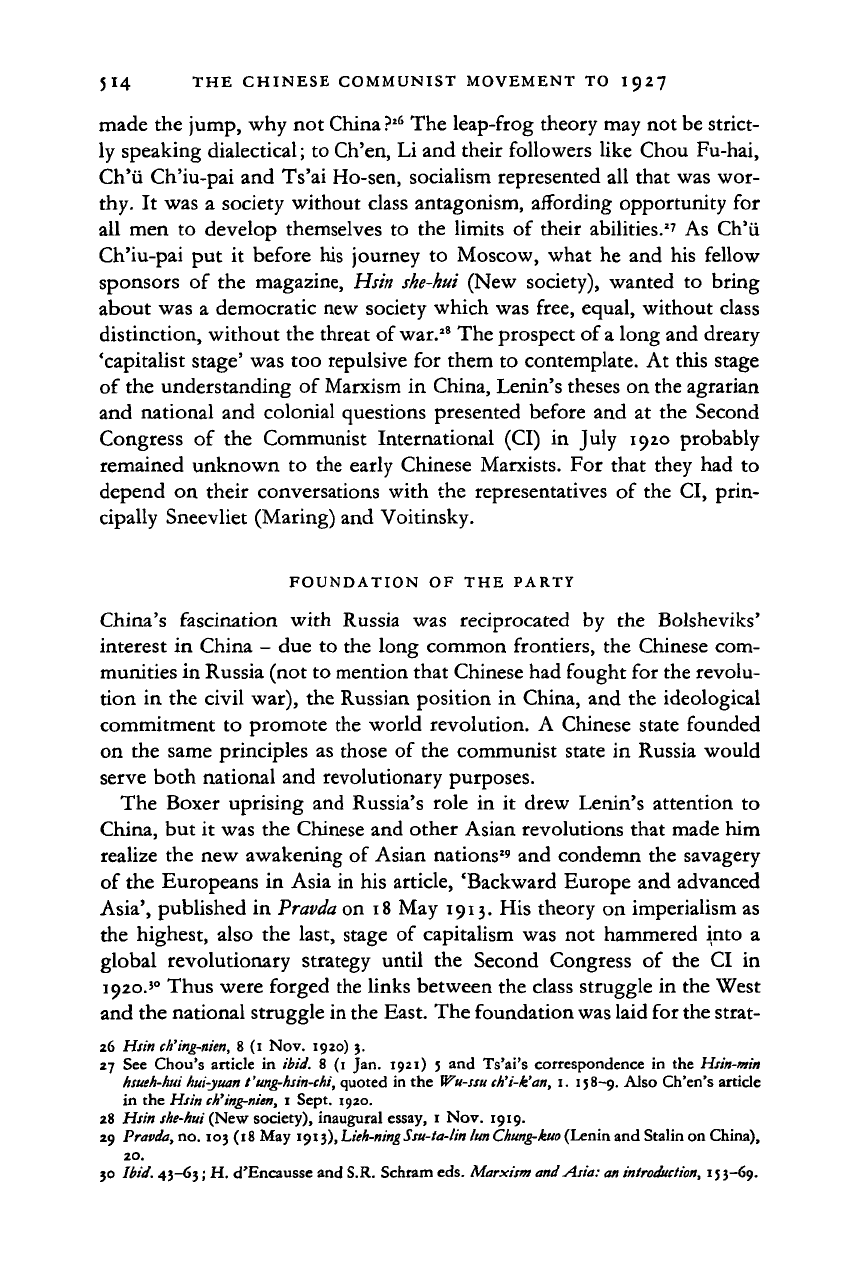
JI4 THE CHINESE COMMUNIST MOVEMENT TO I927
made the jump, why not China?
26
The leap-frog theory may not be strict-
ly speaking dialectical; to Ch'en, Li and their followers like Chou Fu-hai,
Ch'ii Ch'iu-pai and Ts'ai Ho-sen, socialism represented all that was wor-
thy. It was a society without class antagonism, affording opportunity for
all men to develop themselves to the limits of their abilities.
27
As Ch'ii
Ch'iu-pai put it before his journey to Moscow, what he and his fellow
sponsors of the magazine, Hsin
she-hui
(New society), wanted to bring
about was a democratic new society which was free, equal, without class
distinction, without the threat of war.
18
The prospect of
a
long and dreary
'capitalist stage' was too repulsive for them to contemplate. At this stage
of the understanding of Marxism in China, Lenin's theses on the agrarian
and national and colonial questions presented before and at the Second
Congress of the Communist International (CI) in July 1920 probably
remained unknown to the early Chinese Marxists. For that they had to
depend on their conversations with the representatives of the CI, prin-
cipally Sneevliet (Maring) and Voitinsky.
FOUNDATION OF THE PARTY
China's fascination with Russia was reciprocated by the Bolsheviks'
interest in China - due to the long common frontiers, the Chinese com-
munities in Russia (not to mention that Chinese had fought for the revolu-
tion in the civil war), the Russian position in China, and the ideological
commitment to promote the world revolution. A Chinese state founded
on the same principles as those of the communist state in Russia would
serve both national and revolutionary purposes.
The Boxer uprising and Russia's role in it drew Lenin's attention to
China, but it was the Chinese and other Asian revolutions that made him
realize the new awakening of Asian nations
2
' and condemn the savagery
of the Europeans in Asia in his article, 'Backward Europe and advanced
Asia', published in
Pravda
on 18 May 1913. His theory on imperialism as
the highest, also the last, stage of capitalism was not hammered into a
global revolutionary strategy until the Second Congress of the CI in
1920.'° Thus were forged the links between the class struggle in the West
and the national struggle in the East. The foundation was laid for the strat-
26 Hsin
ch'ing-nien,
8 (i Nov. 1920) 3.
27 See Chou's article in
ibid.
8 (1 Jan. 1921) 5 and Ts'ai's correspondence in the Hsin-min
hsueh-lmi hui-yuan
t'ung-hsin-chi,
quoted in the
Wu-ssu
ch'i-k'an,
1. 158-9. Also Ch'en's article
in the Hsin
ch'ing-nien,
1 Sept. 1920.
28 Hsin
she-hui
(New society), inaugural essay, 1 Nov. 1919.
29 Pravda, no. 103 (18 May 1913),
Lieh-ningSsu-ta-lin lunChung-kuo
(Lenin and Stalin on China),
20.
30
Ibid.
43-63; H. d'Encausse and S.R. Schram eds. Marxism and Asia:
an
introduction,
153-69.
Cambridge Histories Online © Cambridge University Press, 2008
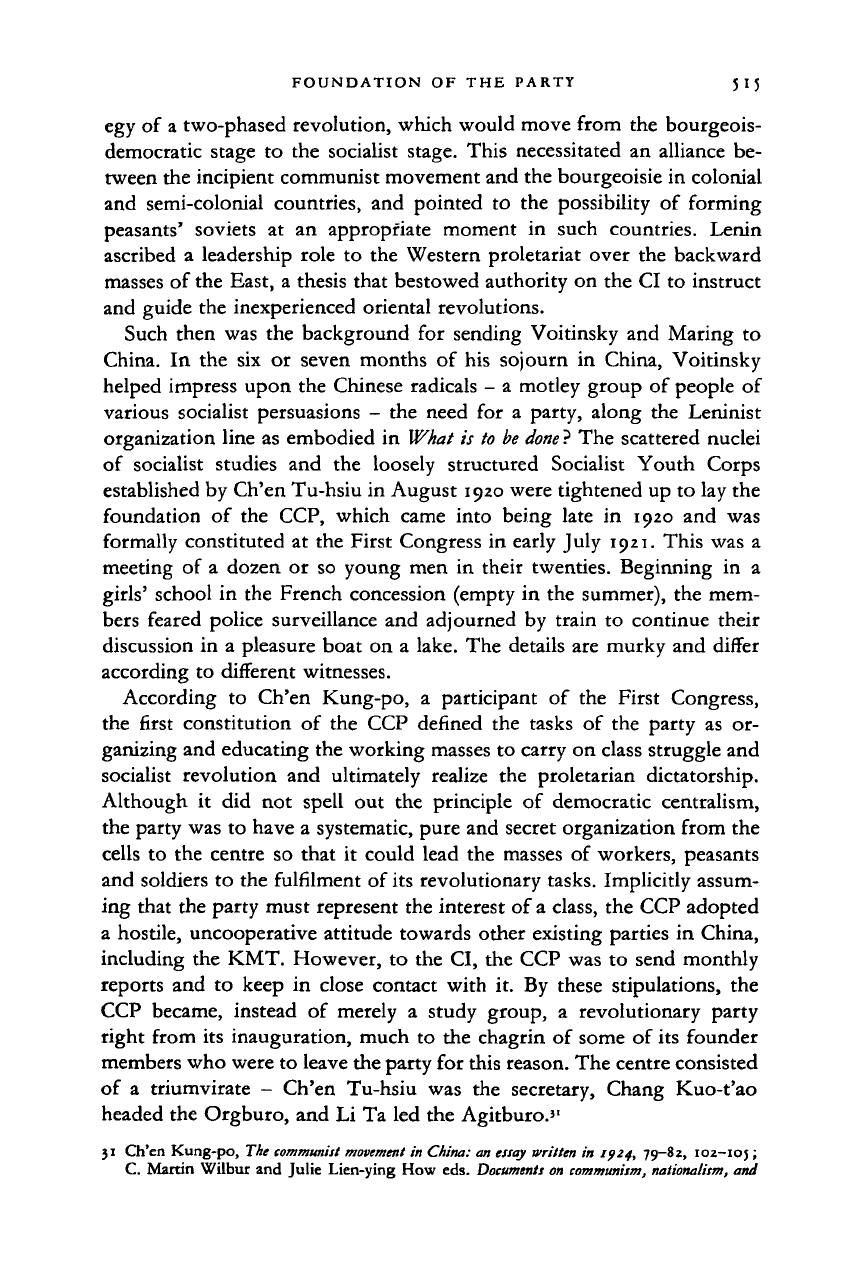
FOUNDATION OF THE PARTY
5
I
5
egy of a two-phased revolution, which would move from the bourgeois-
democratic stage to the socialist stage. This necessitated an alliance be-
tween the incipient communist movement and the bourgeoisie in colonial
and semi-colonial countries, and pointed to the possibility of forming
peasants' Soviets at an appropriate moment in such countries. Lenin
ascribed a leadership role to the Western proletariat over the backward
masses of the East, a thesis that bestowed authority on the CI to instruct
and guide the inexperienced oriental revolutions.
Such then was the background for sending Voitinsky and Maring to
China. In the six or seven months of his sojourn in China, Voitinsky
helped impress upon the Chinese radicals - a motley group of people of
various socialist persuasions - the need for a party, along the Leninist
organization line as embodied in What is to
be done ?
The scattered nuclei
of socialist studies and the loosely structured Socialist Youth Corps
established by Ch'en Tu-hsiu in August 1920 were tightened up to lay the
foundation of the CCP, which came into being late in 1920 and was
formally constituted at the First Congress in early July 1921. This was a
meeting of a dozen or so young men in their twenties. Beginning in a
girls'
school in the French concession (empty in the summer), the mem-
bers feared police surveillance and adjourned by train to continue their
discussion in a pleasure boat on a lake. The details are murky and differ
according to different witnesses.
According to Ch'en Kung-po, a participant of the First Congress,
the first constitution of the CCP defined the tasks of the party as or-
ganizing and educating the working masses to carry on class struggle and
socialist revolution and ultimately realize the proletarian dictatorship.
Although it did not spell out the principle of democratic centralism,
the party was to have a systematic, pure and secret organization from the
cells to the centre so that it could lead the masses of workers, peasants
and soldiers to the fulfilment of its revolutionary tasks. Implicitly assum-
ing that the party must represent the interest of a class, the CCP adopted
a hostile, uncooperative attitude towards other existing parties in China,
including the KMT. However, to the CI, the CCP was to send monthly
reports and to keep in close contact with it. By these stipulations, the
CCP became, instead of merely a study group, a revolutionary party
right from its inauguration, much to the chagrin of some of its founder
members who were to leave the party for this reason. The centre consisted
of a triumvirate - Ch'en Tu-hsiu was the secretary, Chang Kuo-t'ao
headed the Orgburo, and Li Ta led the Agitburo.'
1
31 Ch'en Kung-po, The
communist movement
in
China:
an
essay
written in 1924, 79-82, 102-105;
C.
Martin Wilbur and Julie Lien-ying How eds.
Documents on
communism,
nationalism,
and
Cambridge Histories Online © Cambridge University Press, 2008
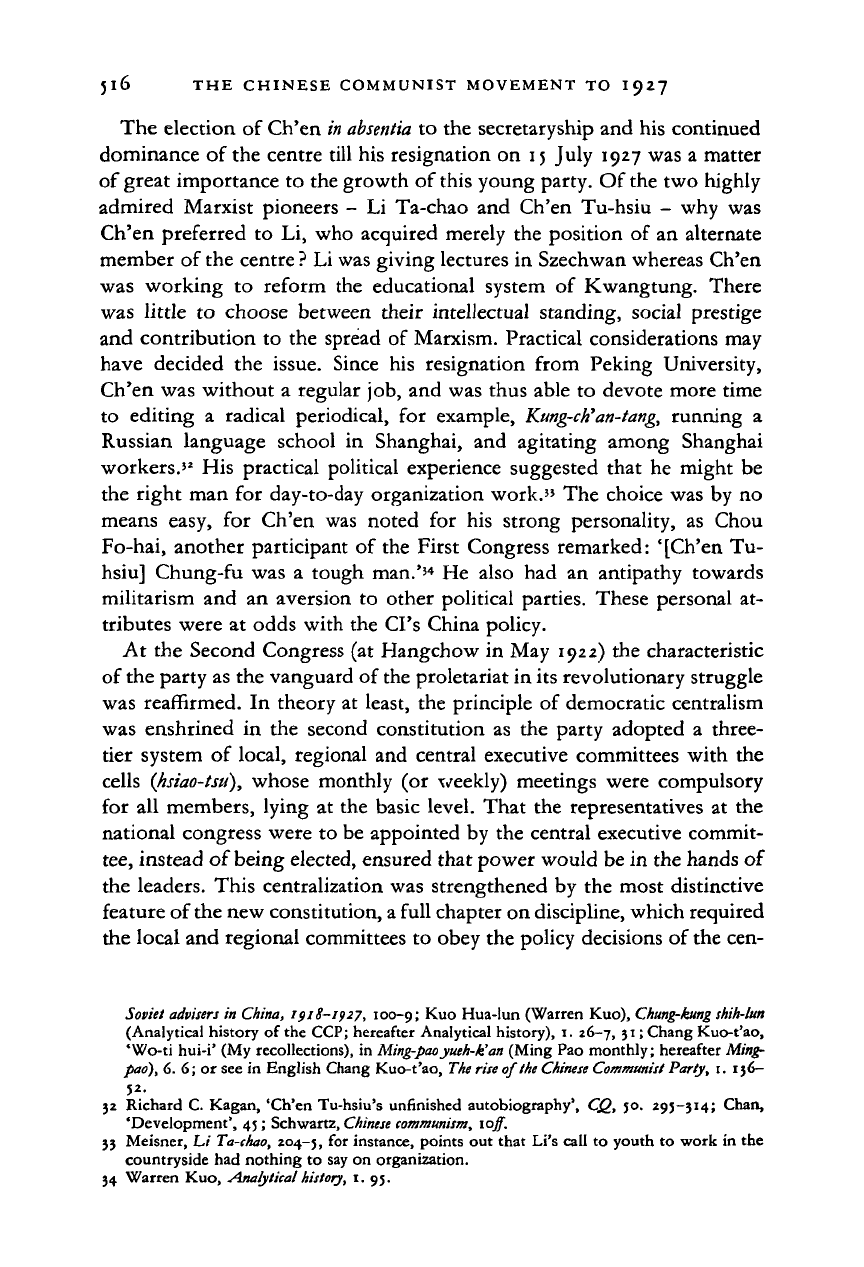
516 THE CHINESE COMMUNIST MOVEMENT TO 1927
The election
of
Ch'en
in absentia
to the
secretaryship
and
his continued
dominance
of
the centre till
his
resignation
on
15 July 1927 was
a
matter
of great importance
to
the growth
of
this young party.
Of
the two highly
admired Marxist pioneers
- Li
Ta-chao
and
Ch'en Tu-hsiu
- why was
Ch'en preferred
to Li, who
acquired merely
the
position
of an
alternate
member
of
the centre
?
Li was giving lectures
in
Szechwan whereas Ch'en
was working
to
reform
the
educational system
of
Kwangtung. There
was little
to
choose between their intellectual standing, social prestige
and contribution
to the
spread
of
Marxism. Practical considerations
may
have decided
the
issue. Since
his
resignation from Peking University,
Ch'en was without
a
regular job,
and
was thus able
to
devote more time
to editing
a
radical periodical,
for
example,
Kung-ch'an-tang,
running
a
Russian language school
in
Shanghai,
and
agitating among Shanghai
workers.'
2
His
practical political experience suggested that
he
might
be
the right
man for
day-to-day organization work."
The
choice was
by no
means easy,
for
Ch'en
was
noted
for his
strong personality,
as
Chou
Fo-hai, another participant
of
the First Congress remarked: '[Ch'en
Tu-
hsiu] Chung-fu
was a
tough man.'
34
He
also
had an
antipathy towards
militarism
and an
aversion
to
other political parties. These personal
at-
tributes were
at
odds with
the CI's
China policy.
At
the
Second Congress
(at
Hangchow
in
May 1922)
the
characteristic
of the party as the vanguard
of
the proletariat in its revolutionary struggle
was reaffirmed.
In
theory
at
least,
the
principle
of
democratic centralism
was enshrined
in the
second constitution
as the
party adopted
a
three-
tier system
of
local, regional
and
central executive committees with
the
cells
(hsiao-tsu),
whose monthly
(or
weekly) meetings were compulsory
for
all
members, lying
at the
basic level. That
the
representatives
at the
national congress were
to be
appointed
by the
central executive commit-
tee,
instead
of
being elected, ensured that power would be
in
the hands
of
the leaders. This centralization was strengthened
by the
most distinctive
feature
of
the new constitution, a full chapter on discipline, which required
the local and regional committees
to
obey the policy decisions
of
the cen-
Soviel advisers
in
China, 1918-1927, 100-9;
Kuo
Hua-lun (Warren Kuo),
Chung-kung shih-lun
(Analytical history of the CCP; hereafter Analytical history), 1. 26-7,
31;
Chang Kuo-t'ao,
'Wo-ti hui-i' (My recollections), in
Ming-paoyueh-k'an
(Ming Pao monthly; hereafter
Ming-
pao),
6. 6; or
see
in
English Chang
Kuo-t'ao,
The rise
of the Chinese
Communist Party,
1.
136—
32
Richard
C.
Kagan, 'Ch'en Tu-hsiu's unfinished autobiography',
CQ, 50.
295-314;
Chan,
'Development',
45;
Schwartz,
Chinese
communism,
\off.
33
Meisner,
hi
Ta-chao,
204-5,
for
instance,
points
out
that
Li's
call
to
youth
to
work
in the
countryside
had
nothing
to
say
on
organization.
34
Warren Kuo, Analytical
history,
1. 95.
Cambridge Histories Online © Cambridge University Press, 2008
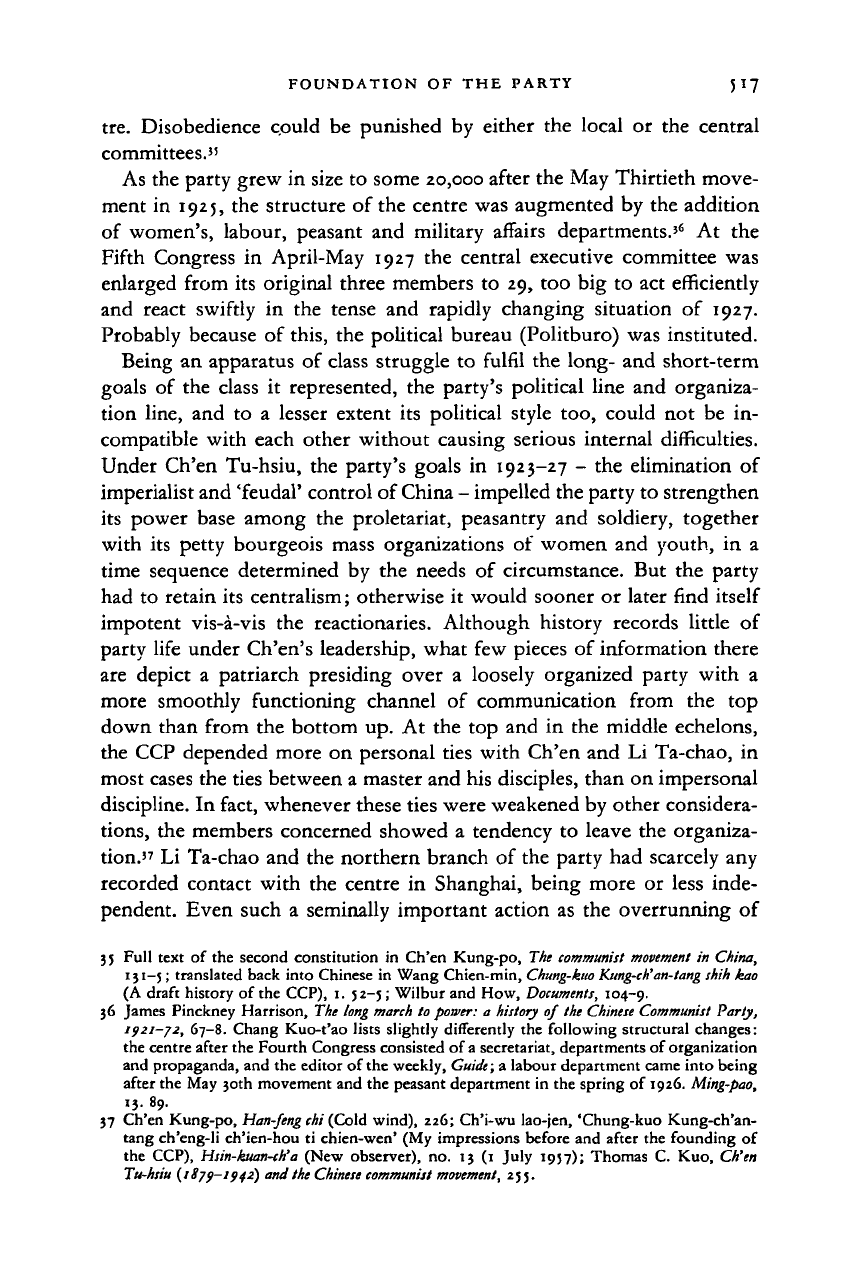
FOUNDATION OF THE PARTY 517
tre.
Disobedience could be punished by either the local or the central
committees."
As the party grew in size to some 20,000 after the May Thirtieth move-
ment in 1925, the structure of the centre was augmented by the addition
of women's, labour, peasant and military affairs departments.'
6
At the
Fifth Congress in April-May 1927 the central executive committee was
enlarged from its original three members to 29, too big to act efficiently
and react swiftly in the tense and rapidly changing situation of 1927.
Probably because of this, the political bureau (Politburo) was instituted.
Being an apparatus of class struggle to fulfil the long- and short-term
goals of the class it represented, the party's political line and organiza-
tion line, and to a lesser extent its political style too, could not be in-
compatible with each other without causing serious internal difficulties.
Under Ch'en Tu-hsiu, the party's goals in 1923-27 - the elimination of
imperialist and 'feudal' control of China - impelled the party to strengthen
its power base among the proletariat, peasantry and soldiery, together
with its petty bourgeois mass organizations of women and youth, in a
time sequence determined by the needs of circumstance. But the party
had to retain its centralism; otherwise it would sooner or later find itself
impotent vis-a-vis the reactionaries. Although history records little of
party life under Ch'en's leadership, what few pieces of information there
are depict a patriarch presiding over a loosely organized party with a
more smoothly functioning channel of communication from the top
down than from the bottom up. At the top and in the middle echelons,
the CCP depended more on personal ties with Ch'en and Li Ta-chao, in
most cases the ties between a master and his disciples, than on impersonal
discipline. In fact, whenever these ties were weakened by other considera-
tions,
the members concerned showed a tendency to leave the organiza-
tion." Li Ta-chao and the northern branch of the party had scarcely any
recorded contact with the centre in Shanghai, being more or less inde-
pendent. Even such a seminally important action as the overrunning of
35
Full text of the second constitution in Ch'en Kung-po, The communist
movement
in China,
151-5;
translated back into Chinese in Wang Chien-min,
Chung-kuo Kung-cK an-tang
shih kao
(A
draft history of the CCP), i. 52-5; Wilbur and How, Documents,
104-9.
36
James Pinckney Harrison, The
long
march to power: a history of the
Chinese
Communist Party,
1921-72,
67-8. Chang Kuo-t'ao lists slightly differently the following structural changes:
the
centre after the Fourth Congress consisted of a secretariat, departments of organization
and
propaganda, and the editor of the weekly, Guide; a labour department came into being
after
the May 30th movement and the peasant department in the spring of 1926. Ming-pao,
13-
89-
37
Ch'en Kung-po, Han-feng chi (Cold
wind),
226; Ch'i-wu lao-jen, 'Chung-kuo Kung-ch'an-
tang
ch'eng-li ch'ien-hou ti chien-wen" (My impressions before and after the founding of
the
CCP), Hsin-kuan-ch'a (New observer), no. 15 (1 July
1957);
Thomas C. Kuo, Ch'en
Tu-hsiu
(1879-1942) and
the Chinese communist
movement,
255.
Cambridge Histories Online © Cambridge University Press, 2008
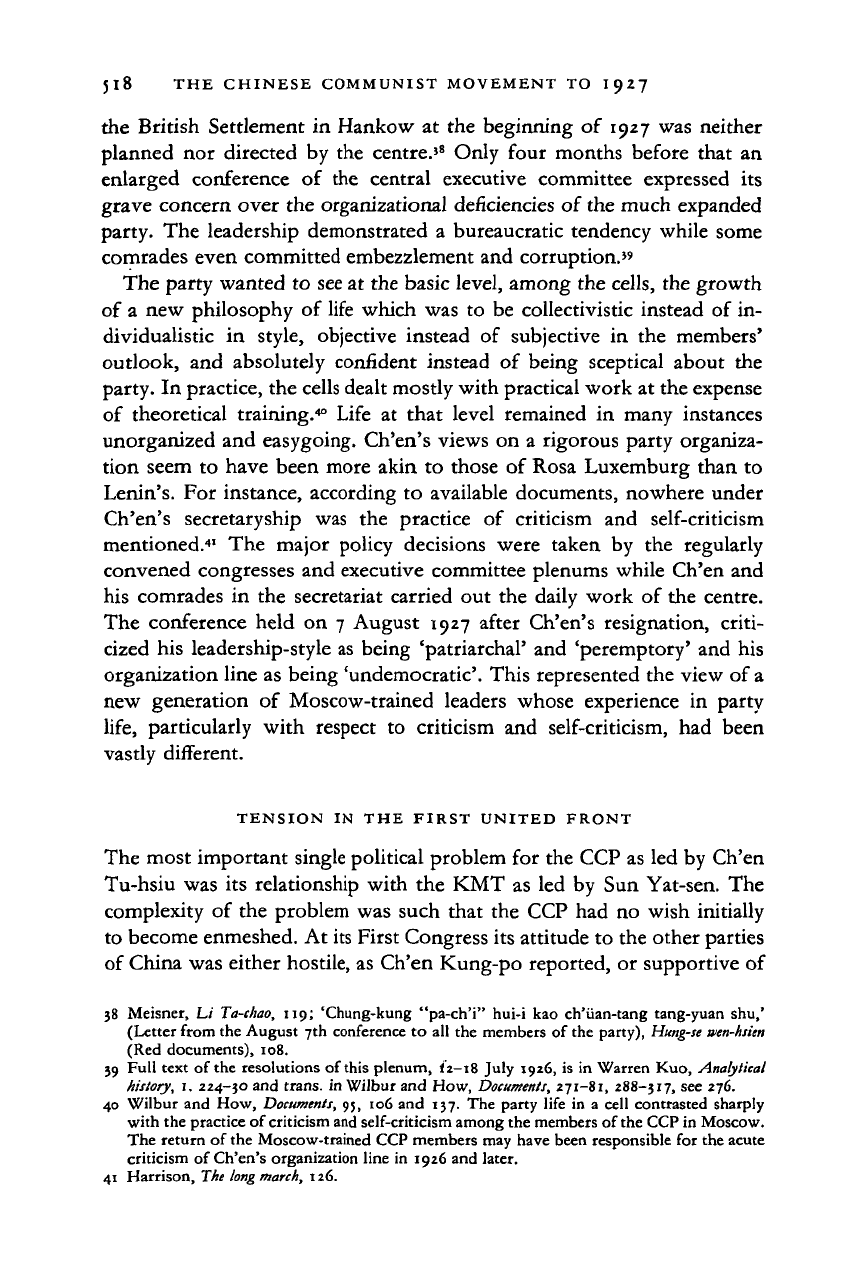
Jl8
THE
CHINESE COMMUNIST MOVEMENT
TO
I927
the British Settlement
in
Hankow
at
the
beginning
of
1927 was
neither
planned
nor
directed
by the
centre.
58
Only four months before that
an
enlarged conference
of
the
central executive committee expressed
its
grave concern over
the
organizational deficiencies
of the
much expanded
party.
The
leadership demonstrated
a
bureaucratic tendency while some
comrades even committed embezzlement
and
corruption."
The party wanted
to
see
at the
basic level, among
the
cells,
the
growth
of
a
new
philosophy
of
life which
was
to
be
collectivistic instead
of in-
dividualistic
in
style, objective instead
of
subjective
in the
members'
outlook,
and
absolutely confident instead
of
being sceptical about
the
party.
In
practice,
the
cells dealt mostly with practical work
at the
expense
of theoretical training.
40
Life
at
that level remained
in
many instances
unorganized
and
easygoing. Ch'en's views
on
a
rigorous party organiza-
tion seem
to
have been more akin
to
those
of
Rosa Luxemburg than
to
Lenin's.
For
instance, according
to
available documents, nowhere under
Ch'en's secretaryship
was the
practice
of
criticism
and
self-criticism
mentioned.
41
The
major policy decisions were taken
by the
regularly
convened congresses
and
executive committee plenums while Ch'en
and
his comrades
in
the
secretariat carried
out the
daily work
of
the
centre.
The conference held
on
7
August
1927
after Ch'en's resignation, criti-
cized
his
leadership-style
as
being 'patriarchal'
and
'peremptory'
and his
organization line
as
being 'undemocratic'. This represented
the
view
of
a
new generation
of
Moscow-trained leaders whose experience
in
party
life,
particularly with respect
to
criticism
and
self-criticism,
had
been
vastly different.
TENSION IN THE FIRST UNITED FRONT
The most important single political problem
for the CCP as led by
Ch'en
Tu-hsiu
was its
relationship with
the KMT as led by Sun
Yat-sen.
The
complexity
of
the
problem
was
such that
the CCP had no
wish initially
to become enmeshed.
At its
First Congress
its
attitude
to the
other parties
of China
was
either hostile,
as
Ch'en Kung-po reported,
or
supportive
of
38 Meisner,
Li
Ta-chao,
119; 'Chung-kung "pa-ch'i" hui-i
kao
ch'iian-tang tang-yuan shu,'
(Letter from the August
7th
conference
to all
the members
of
the party),
Hung-se wen-hsien
(Red documents), 108.
39 Full text
of
the resolutions of this plenum, ii—18 July 1926,
is in
Warren Kuo, Analytical
history,
1.
224-30 and trans, in Wilbur and How,
Documents,
271-81,
288-317, see 276.
40 Wilbur and How,
Documents,
95, 106 and 137. The party life
in a
cell contrasted sharply
with the practice of criticism and self-criticism among the members
of
the CCP in Moscow.
The return
of
the Moscow-trained CCP members may have been responsible
for
the acute
criticism
of
Ch'en's organization line
in
1926 and later.
41 Harrison, The
long
march,
126.
Cambridge Histories Online © Cambridge University Press, 2008
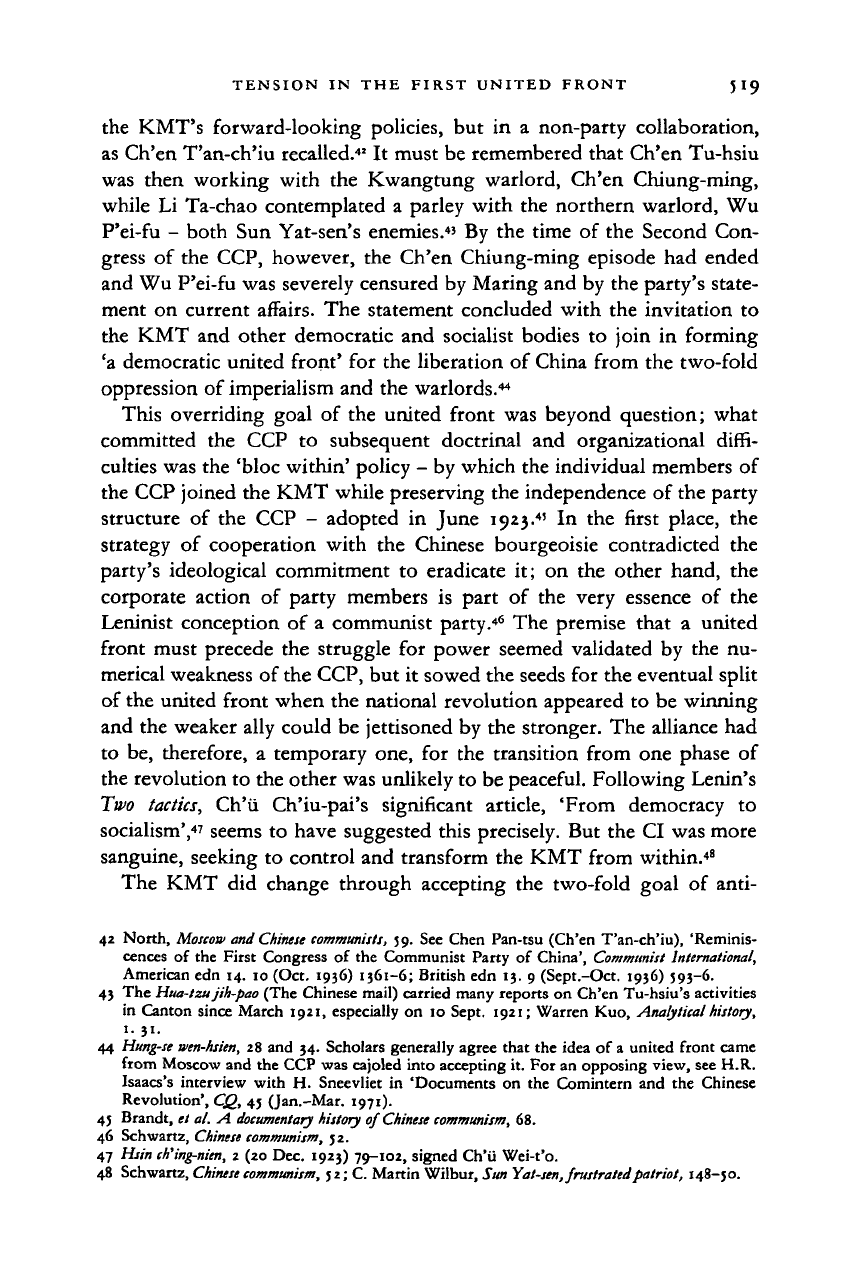
TENSION IN THE FIRST UNITED FRONT
5
19
the KMT's forward-looking policies, but in a non-party collaboration,
as Ch'en T'an-ch'iu recalled.
42
It must be remembered that Ch'en Tu-hsiu
was then working with the Kwangtung warlord, Ch'en Chiung-ming,
while Li Ta-chao contemplated a parley with the northern warlord, Wu
P'ei-fu - both Sun Yat-sen's enemies.
4
' By the time of the Second Con-
gress of the CCP, however, the Ch'en Chiung-ming episode had ended
and Wu P'ei-fu was severely censured by Maring and by the party's state-
ment on current affairs. The statement concluded with the invitation to
the KMT and other democratic and socialist bodies to join in forming
'a democratic united front' for the liberation of China from the two-fold
oppression of imperialism and the warlords.
44
This overriding goal of the united front was beyond question; what
committed the CCP to subsequent doctrinal and organizational diffi-
culties was the 'bloc within' policy - by which the individual members of
the CCP joined the KMT while preserving the independence of the party
structure of the CCP - adopted in June
i923.
4!
In the first place, the
strategy of cooperation with the Chinese bourgeoisie contradicted the
party's ideological commitment to eradicate it; on the other hand, the
corporate action of party members is part of the very essence of the
Leninist conception of a communist party.
46
The premise that a united
front must precede the struggle for power seemed validated by the nu-
merical weakness of the CCP, but it sowed the seeds for the eventual split
of the united front when the national revolution appeared to be winning
and the weaker ally could be jettisoned by the stronger. The alliance had
to be, therefore, a temporary one, for the transition from one phase of
the revolution to the other was unlikely to be peaceful. Following Lenin's
Two tactics, Ch'ii Ch'iu-pai's significant article, 'From democracy to
socialism',
47
seems to have suggested this precisely. But the CI was more
sanguine, seeking to control and transform the KMT from within.
48
The KMT did change through accepting the two-fold goal of anti-
42 North, Moscoa and
Chinese
communists,
59. See Chen Pan-tsu (Ch'en T'an-ch'iu), 'Reminis-
cences of the First Congress of the Communist Party of China',
Communist
International,
American edn 14. 10 (Oct. 1936) 1361-6; British edn 13. 9 (Sept.-Oct. 1936) 593-6.
43 The Hua-tzu jih-pao (The Chinese mail) carried many reports on Ch'en Tu-hsiu's activities
in Canton since March 1921, especially on 10 Sept. 1921; Warren Kuo, Analytical
history,
1.
31.
44
Hung-se
wen-hsien,
28 and 34. Scholars generally agree that the idea of a united front came
from Moscow and the CCP was cajoled into accepting it. For an opposing view, see H.R.
Isaacs's interview with H. Sneevliet in 'Documents on the Comintern and the Chinese
Revolution', CQ, 45 (Jan.-Mar. 1971).
45 Brandt, et al. A
documentary history
oj
Chinese
communism,
68.
46 Schwartz,
Chinese
communism,
52.
47 Hsin
ch'ing-nien,
2 (20 Dec. 1923) 79-102, signed Ch'ii Wei-t'o.
48 Schwartz,
Chinese
communism,
52; C. Martin Wilbur, Sun Yat-sen, frustrated patriot, 148-50.
Cambridge Histories Online © Cambridge University Press, 2008

J2O THE CHINESE COMMUNIST MOVEMENT TO 1927
imperialism and anti-feudalism as enunciated in its manifesto of 1924 and
through its reorganization to don a Leninist mantle.
49
After the inaugura-
tion of the united front, the CCP sought to influence the KMT by in-
troducing its members into the mass movement departments of the KMT
centre and into the Whampoa Military Academy. The fact that KMT
members showed a greater interest in the departments traditionally
regarded as prestigious and substantive, for example, finance and foreign
affairs, instead of organization, propaganda, labour, or peasants, indicated
an unchanged KMT view of party organization and revolution. The
conservatives struggled for positions in the government or the generalis-
simo's headquarters, where there were power and money. Meanwhile
the CCP official organs,
Hsiang-tao chou-pao
(Guide weekly) Hsin
ch'ing-
nien
and
Ch'ien-feng
(Vanguard) never ceased to criticize the organizational
deficiencies and compromising tendencies of the KMT. These efforts,
together with Russian aid and the presence of Russian advisers, contrib-
uted to the emergence of
a
left wing in the KMT, thus gradually splitting
the party after the death of its founder, Sun Yat-sen, in the spring of
1925 (see chapter 11).
50
With the KMT party structure falling into the
hands of the left while the government remained in the grasp of the right,
Borodin, Stalin's envoy who was the political adviser to the KMT, hoped
for the formation of
a
central faction to unite and dominate the party."
The schism within the KMT caused the CCP to reformulate its theory
of the united front, from which the right-wing KMT, characterized by
Ch'en Tu-hsiu as 'counter-revolutionary','
2
had departed while the cen-
tral faction kept its inscrutability and the KMT left wing had 'revolution-
ary tendencies but [was] prone to compromise'. Ch'en, consequently,
switched from his earlier position that only the bourgeoisie had the ability
to lead the bourgeois democratic revolution to a position that only the
proletariat could assume the hegemony. In Moscow at about the same
time,
Stalin presented his view that the KMT was in fact a bloc of four
classes - workers, peasants, urban petty bourgeoisie and grande (national)
bourgeoisie;" hence theoretically it was possible for the CCP to remain
in it so as to preserve the 'bloc within' alliance and to work for the trans-
formation of the KMT.
In more pragmatic terms, the CCP reaped the benefit of the KMT's
49 The KMT Department of Organization, Ti-i-lz'u
ch'iian-hio
ta-hui
hsuan-yen
(Manifesto of
the First National Congress), n.p. Aug. 1927. See also Wilbur,
ibid.
172-4.
50 Jerome Ch'en, 'The left-wing Kuomintang - a definition',
Bulletin
of
the School
of Oriental and
African Studies, 25. 3 (1962).
51 Harrison, The
long
march,
58.
52 Hsiang-tao
chou-pao
(The guide weekly), 101 (7 Nov. 1925) 844-5.
53 d'Encausse and Schram, Marxism, 228.
Cambridge Histories Online © Cambridge University Press, 2008
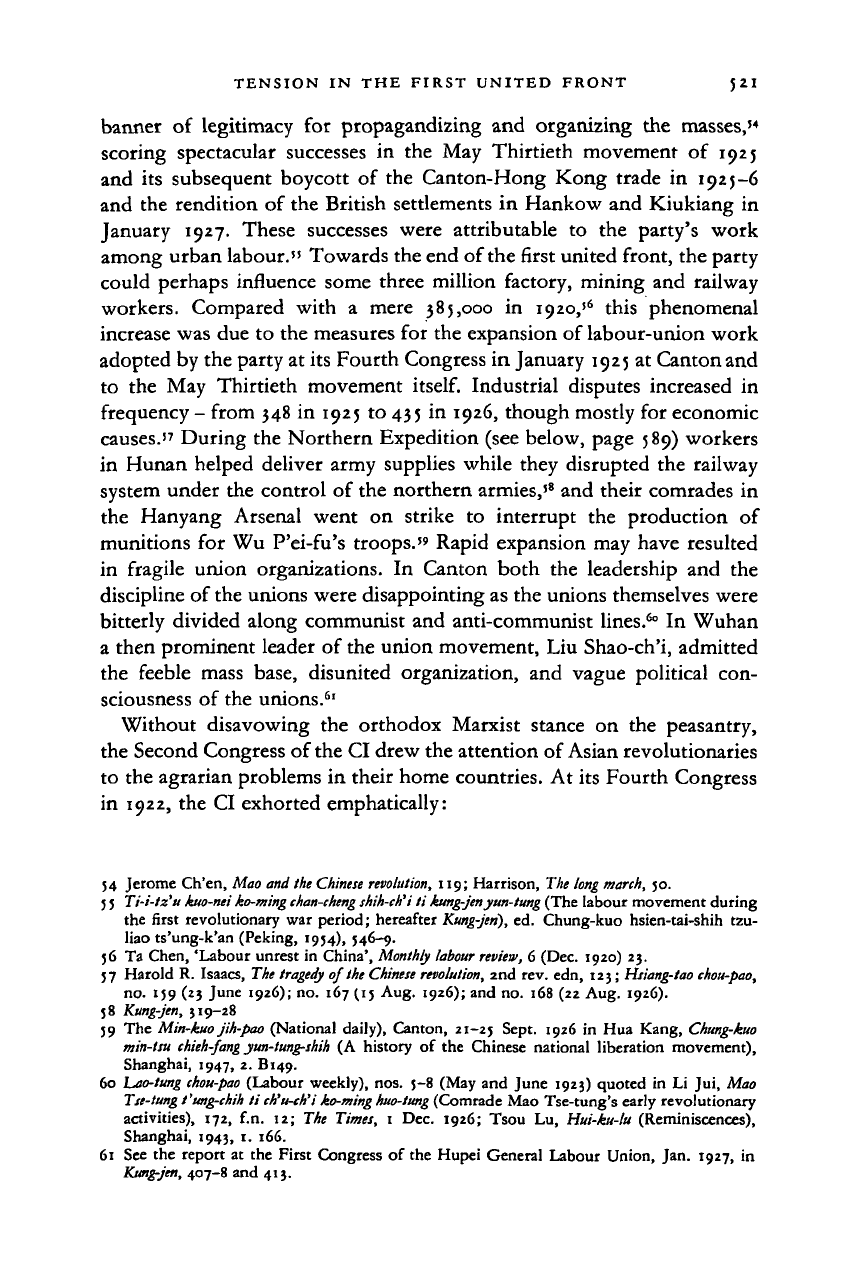
TENSION IN THE FIRST UNITED FRONT J2I
banner of legitimacy for propagandizing and organizing the masses,'
4
scoring spectacular successes in the May Thirtieth movement of 1925
and its subsequent boycott of the Canton-Hong Kong trade in 1925-6
and the rendition of the British settlements in Hankow and Kiukiang in
January 1927. These successes were attributable to the party's work
among urban labour." Towards the end of the first united front, the party
could perhaps influence some three million factory, mining and railway
workers. Compared with a mere 385,000 in 192c,'
6
this phenomenal
increase was due to the measures for the expansion of labour-union work
adopted by the party at its Fourth Congress in January 1925 at Canton and
to the May Thirtieth movement
itself.
Industrial disputes increased in
frequency - from 348 in 1925 to 435 in 1926, though mostly for economic
causes." During the Northern Expedition (see below, page 589) workers
in Hunan helped deliver army supplies while they disrupted the railway
system under the control of the northern armies,'
8
and their comrades in
the Hanyang Arsenal went on strike to interrupt the production of
munitions for Wu P'ei-fu's troops." Rapid expansion may have resulted
in fragile union organizations. In Canton both the leadership and the
discipline of the unions were disappointing as the unions themselves were
bitterly divided along communist and anti-communist lines.
6
" In Wuhan
a then prominent leader of the union movement, Liu Shao-ch'i, admitted
the feeble mass base, disunited organization, and vague political con-
sciousness of the unions.
6
'
Without disavowing the orthodox Marxist stance on the peasantry,
the Second Congress of the CI drew the attention of Asian revolutionaries
to the agrarian problems in their home countries. At its Fourth Congress
in 1922, the CI exhorted emphatically:
54 Jerome Ch'en, Mao and
the Chinese
revolution,
119; Harrison, The
long
march,
50.
5 5
Ti-i-tz'u
kuo-nei ko-ming chan-cheng shih-ch'i
ti
kung-jenyun-tung
(The labour movement during
the first revolutionary war period; hereafter
Kung-jen),
ed. Chung-kuo hsien-tai-shih tzu-
liao ts'ung-k'an (Peking, 1954), 546-9.
56 Ta Chen, 'Labour unrest in China',
Monthly labour
review,
6 (Dec. 1920) 23.
57 Harold R. Isaacs,
The tragedy
of
the Chinese
revolution,
2nd rev. edn, 123;
Hsiang-tao
chou-pao,
no.
159 (23 June 1926); no. 167 (15 Aug. 1926); and no. 168 (22 Aug. 1926).
58
Kung-jen,
319-28
J9 The
Min-kuo
jih-pao (National daily), Canton, 21-25 Sept. 1926 in Hua Kang,
Chung-kuo
min-tsu
chieh-fang yun-tung-shih
(A history of the Chinese national liberation movement),
Shanghai, 1947, 2. B149.
60 Lao-tung
chou-pao
(Labour weekly), nos. 5-8 (May and June 1923) quoted in Li Jui, Mao
Tse-tung
t'ung-chih
tich'u-ch'iko-ming
huo-tung
(Comrade Mao Tse-tung's early revolutionary
activities), 172, f.n. 12; The Times, 1 Dec. 1926; Tsou Lu, Hui-ku-lu (Reminiscences),
Shanghai, 1943, 1. 166.
61 See the report at the First Congress of the Hupei General Labour Union, Jan. 1927, in
Kung-jen,
407-8 and 413.
Cambridge Histories Online © Cambridge University Press, 2008
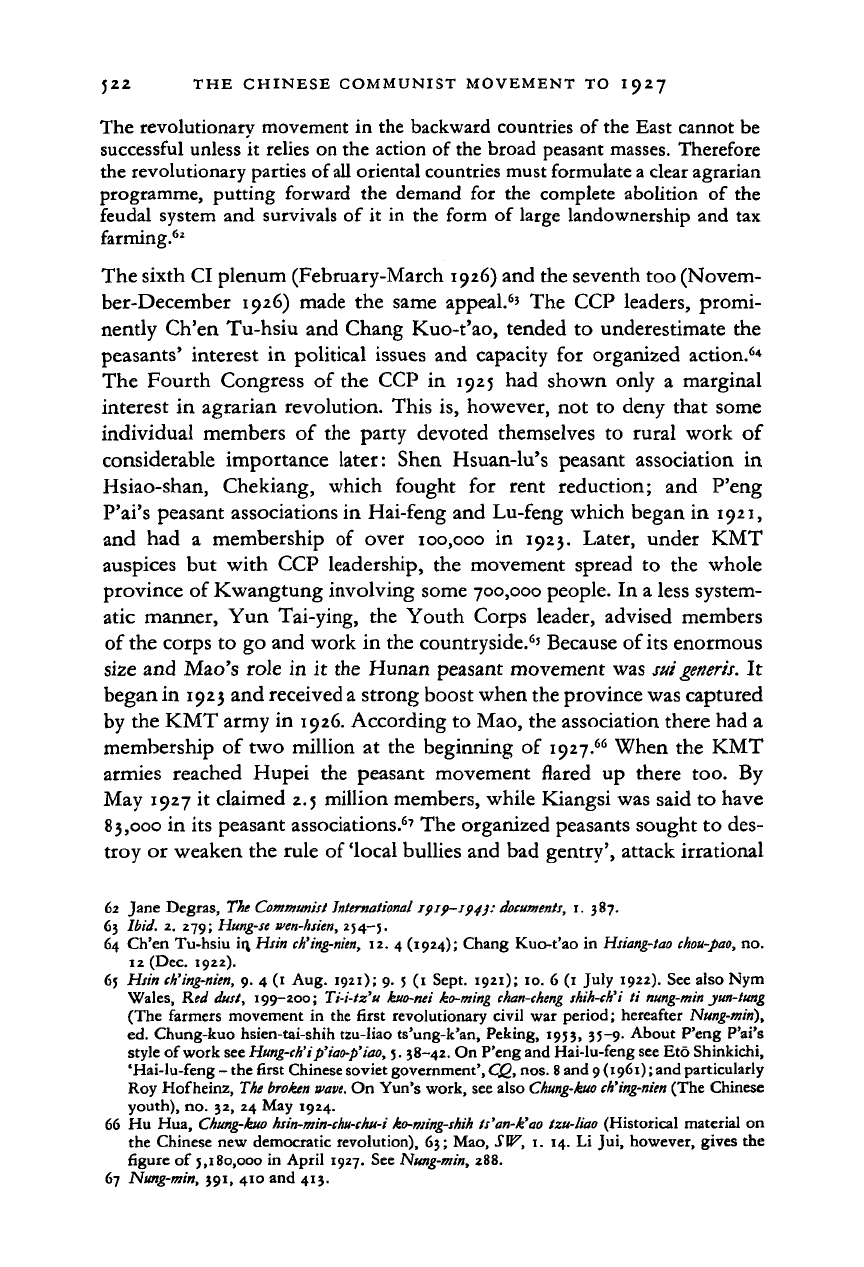
522
THE CHINESE COMMUNIST MOVEMENT TO 1927
The revolutionary movement in the backward countries of the East cannot be
successful unless it relies on the action of the broad peasant masses. Therefore
the revolutionary parties of all oriental countries must formulate
a
clear agrarian
programme, putting forward the demand for the complete abolition of the
feudal system and survivals of it in the form of large landownership and tax
farming.
62
The sixth CI plenum (February-March 1926) and the seventh too (Novem-
ber-December 1926) made the same appeal.
6
' The CCP leaders, promi-
nently Ch'en Tu-hsiu and Chang Kuo-t'ao, tended to underestimate the
peasants' interest in political issues and capacity for organized action.
6
*
The Fourth Congress of the CCP in 1925 had shown only a marginal
interest in agrarian revolution. This is, however, not to deny that some
individual members of the party devoted themselves to rural work of
considerable importance later: Shen Hsuan-lu's peasant association in
Hsiao-shan, Chekiang, which fought for rent reduction; and P'eng
P'ai's peasant associations in Hai-feng and Lu-feng which began in 1921,
and had a membership of over 100,000 in 1923. Later, under KMT
auspices but with CCP leadership, the movement spread to the whole
province of Kwangtung involving some 700,000 people. In a less system-
atic manner, Yun Tai-ying, the Youth Corps leader, advised members
of the corps to go and work in the countryside.
6
' Because of
its
enormous
size and Mao's role in it the Hunan peasant movement was
sui
generis.
It
began in 1923 and received a strong boost when the province was captured
by the KMT army in 1926. According to Mao, the association there had a
membership of two million at the beginning of 1927.
66
When the KMT
armies reached Hupei the peasant movement flared up there too. By
May 1927 it claimed 2.5 million members, while Kiangsi was said to have
83,000 in its peasant associations.'
7
The organized peasants sought to des-
troy or weaken the rule of 'local bullies and bad gentry', attack irrational
62
Jane Degras, The
Communist International
1019—194):
documents,
i. 387.
63
Ibid. 2. 279;
Hung-se
wen-hsien,
254—5.
64
Ch'en Tu-hsiu in, Hsin
ch'ing-nitn,
12. 4 (1924); Chang Kuo-t'ao in
Hsiang-tao
chou-pao,
no.
12 (Dec. 1922).
65
Hsin
ch'ing-nien,
9. 4 (1 Aug. 1921); 9. 5 (1 Sept. 1921); 10. 6 (1 July 1922). See also Nym
Wales,
Red dust, 199-200; Ti-i-tz'u
kuo-nei
ko-ming
chan-cheng shih-ch'i
ti
nung-min yun-tung
(The
farmers movement in the first revolutionary civil war period; hereafter Nung-min),
ed.
Chung-kuo hsien-tai-shih tzu-liao ts'ung-k'an, Peking, 1953, 35-9- About P'eng P'ai's
style of work
see
Hung-ch'ip'iao-p'iao,
5.
38-42.
On P'eng and Hai-lu-feng see Eto Shinkichi,
'Hai-lu-feng
- the first Chinese soviet government', CQ, nos.
8
and 9
(1961);
and particularly
Roy Hof
heinz,
The broken
wave.
On Yun's work, see also
Chung-kuo ch'ing-nien
(The Chinese
youth),
no. 32, 24 May 1924.
66
Hu Hua,
Chung-kuo hsin-min-chu-chu-i ko-ming-shih
ts'an-k'ao tzu-liao (Historical material on
the Chinese new democratic revolution), 63; Mao, SW, 1. 14. Li Jui, however, gives the
figure of 5,180,000 in April 1927. See Nung-min, 288.
67 Nung-min, 391, 410 and 413.
Cambridge Histories Online © Cambridge University Press, 2008
